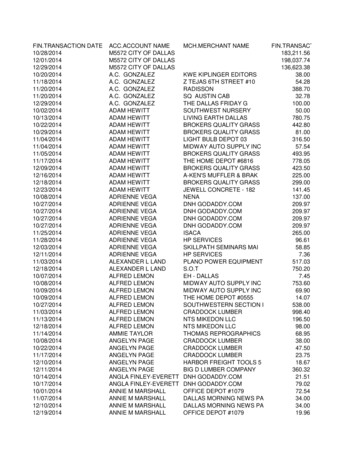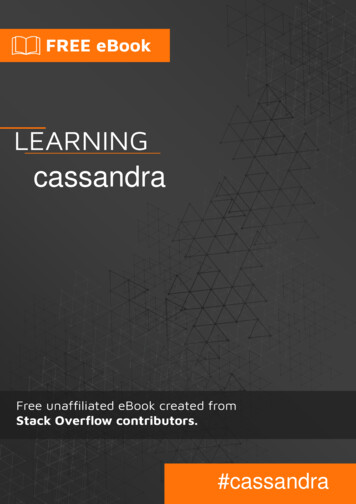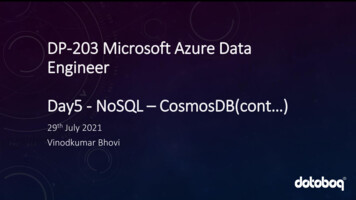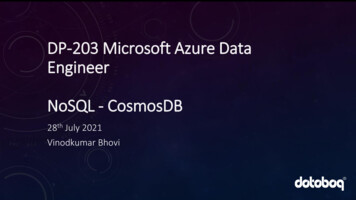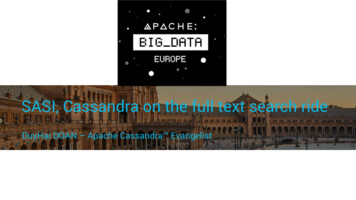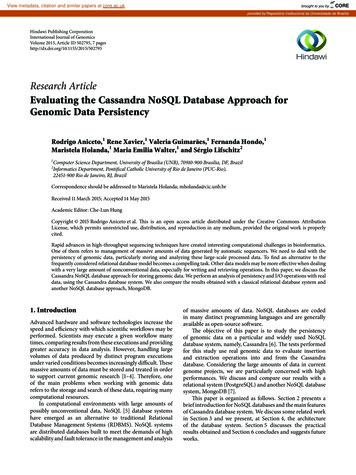
Transcription
View metadata, citation and similar papers at core.ac.ukbrought to you byCOREprovided by Repositório Institucional da Universidade de BrasíliaHindawi Publishing CorporationInternational Journal of GenomicsVolume 2015, Article ID 502795, 7 pageshttp://dx.doi.org/10.1155/2015/502795Research ArticleEvaluating the Cassandra NoSQL Database Approach forGenomic Data PersistencyRodrigo Aniceto,1 Rene Xavier,1 Valeria Guimarães,1 Fernanda Hondo,1Maristela Holanda,1 Maria Emilia Walter,1 and Sérgio Lifschitz21Computer Science Department, University of Brasilia (UNB), 70910-900 Brasilia, DF, BrazilInformatics Department, Pontifical Catholic University of Rio de Janeiro (PUC-Rio),22451-900 Rio de Janeiro, RJ, Brazil2Correspondence should be addressed to Maristela Holanda; mholanda@cic.unb.brReceived 11 March 2015; Accepted 14 May 2015Academic Editor: Che-Lun HungCopyright 2015 Rodrigo Aniceto et al. This is an open access article distributed under the Creative Commons AttributionLicense, which permits unrestricted use, distribution, and reproduction in any medium, provided the original work is properlycited.Rapid advances in high-throughput sequencing techniques have created interesting computational challenges in bioinformatics.One of them refers to management of massive amounts of data generated by automatic sequencers. We need to deal with thepersistency of genomic data, particularly storing and analyzing these large-scale processed data. To find an alternative to thefrequently considered relational database model becomes a compelling task. Other data models may be more effective when dealingwith a very large amount of nonconventional data, especially for writing and retrieving operations. In this paper, we discuss theCassandra NoSQL database approach for storing genomic data. We perform an analysis of persistency and I/O operations with realdata, using the Cassandra database system. We also compare the results obtained with a classical relational database system andanother NoSQL database approach, MongoDB.1. IntroductionAdvanced hardware and software technologies increase thespeed and efficiency with which scientific workflows may beperformed. Scientists may execute a given workflow manytimes, comparing results from these executions and providinggreater accuracy in data analysis. However, handling largevolumes of data produced by distinct program executionsunder varied conditions becomes increasingly difficult. Thesemassive amounts of data must be stored and treated in orderto support current genomic research [1–4]. Therefore, oneof the main problems when working with genomic datarefers to the storage and search of these data, requiring manycomputational resources.In computational environments with large amounts ofpossibly unconventional data, NoSQL [5] database systemshave emerged as an alternative to traditional RelationalDatabase Management Systems (RDBMS). NoSQL systemsare distributed databases built to meet the demands of highscalability and fault tolerance in the management and analysisof massive amounts of data. NoSQL databases are codedin many distinct programming languages and are generallyavailable as open-source software.The objective of this paper is to study the persistencyof genomic data on a particular and widely used NoSQLdatabase system, namely, Cassandra [6]. The tests performedfor this study use real genomic data to evaluate insertionand extraction operations into and from the Cassandradatabase. Considering the large amounts of data in currentgenome projects, we are particularly concerned with highperformances. We discuss and compare our results with arelational system (PostgreSQL) and another NoSQL databasesystem, MongoDB [7].This paper is organized as follows. Section 2 presents abrief introduction for NoSQL databases and the main featuresof Cassandra database system. We discuss some related workin Section 3 and we present, at Section 4, the architectureof the database system. Section 5 discusses the practicalresults obtained and Section 6 concludes and suggests futureworks.
2International Journal of Genomics2. NoSQL Databases: An OverviewMany relevant innovations in data management came fromWeb 2.0 applications. However, the techniques and toolsavailable in relational systems may, sometimes, limit theirdeployment. Therefore, some researchers have decided todevelop their own web-scale database solutions [8].NoSQL (not-only SQL) databases have emerged as asolution to storage scalability issues, parallelism, and management of large volumes of unstructured data. In general,NoSQL systems have the following characteristics [8–10]: (i)they are based on a nonrelational data model; (ii) they relyon distributed processing; (iii) high availability and scalabilityare main concerns; and (iv) some are schemaless and have theability to handle both structured and unstructured data.There are four main categories of NoSQL databases [8, 11–13]:(i) Key-value stores: data is stored as key-pairs values.These systems are similar to dictionaries, where datais addressed by a single key. Values are isolatedand independent from another, and relationships arehandled by the application logic.(ii) Column family database: it defines the data structureas a predefined set of columns. The super columnsand column family structures can be considered thedatabase schema.(iii) Document-based storage: a document store uses theconcept of key-value store. The documents are collections of attributes and values, where an attributecan be multivalued. Each document contains an IDkey, which is unique within a collection and identifiesdocument.(iv) Graph databases: graphs are used to representschemas. A graph database works with three abstractions: node, relationships between nodes, and keyvalue pairs that can attach to nodes and relationships.2.1. Cassandra Database System. Cassandra is a cloudoriented database system, massively scalable, designed tostore a large amount of data from multiple servers, whileproviding high availability and consistent data [6]. It is basedon the architecture of Amazon’s Dynamo [14] and also onGoogle’s BigTable data model [15]. Cassandra enables queriesas in a key-value model, where each row has a unique rowkey, a feature adopted from Dynamo [6, 14, 16, 17]. Cassandrais considered a hybrid NoSQL database, using characteristicsof both key-value and column oriented databases.Cassandra’s architecture is made of nodes, clusters, datacenters and a partitioner. A node is a physical instance ofCassandra. Cassandra does not use a master-slave architecture; rather, Cassandra uses peer-to-peer architecture, whichall nodes are equal. A cluster is a group of nodes or even asingle node. A group of clusters is a data center. A partitioneris a hash function for computing the token of each row key.When one row is inserted, a token is calculated, basedon its unique row key. This token determines in what nodethat particular row will be stored. Each node of a cluster isresponsible for a range of data based on a token. When therow is inserted and its token is calculated, this row is stored ona node responsible for this token. The advantage here is thatmultiple rows can be written in parallel into the database, aseach node is responsible for its own write requests. Howeverthis may be seen as a drawback regarding data extraction,becoming a bottleneck. The MurMur3Partitioner [17] is apartitioner that uses tokens to assign equal portions of datato each node. This technique was selected because it providesfast hashing, and its hash function helps to evenly distributedata to all the nodes of a cluster.The main elements of Cassandra are keyspaces, columnfamilies, columns, and rows [18]. A keyspace contains theprocessing steps of the data replication and is similar to aschema in a relational database. Typically, a cluster has onekeyspace per application. A column family is a set of keyvalue pairs containing a column with its unique row keys. Acolumn is the smallest increment of data, which contains aname, a value, and a timestamp. Rows are columns with thesame primary key.When a write operation occurs, Cassandra immediatelystores the instruction on the Commit log, which goes into thehard disk (HD). Data from this write operation is stored atthe memtable, which stays in RAM. Only when a predefinedmemory limit is reached, this data is written on SSTables thatstay in the HD. Then, the Commit log and the memtable arecleaned up [18, 19]. In case of failure regarding the memtables,Cassandra reexecutes the written instructions available at theCommit log [19, 20].When an extract instruction is executed, Cassandra firstsearches information in memtables. A large RAM allows largeamounts of data in memtables and less data in HD, resultingin quick access to information [16].3. Storing Genomic DataPersistency of genomic data is not a recent problem. In 2004,Bloom and Sharpe [21] described the difficulties of managingthese data. One of the main difficulties was the growingnumber of data generated by the queries. The work in Röhmand Blakeley [22] and Huacarpuma [23] consider relationaldatabases (SQL Server 2008 and PostgreSQL, resp.) to storegenomic data in FASTQ format.Bateman and Wood [24] have suggested using NoSQLdatabases as a good alternative to persisting genetic data.However, no practical results are given. Ye and Li [25]proposed the use of Cassandra as a storage system. Theyconsider multiple nodes so that there were no gaps in theconsistency of the data. Wang and Tang [26] indicated someinstructions for creating an application to perform dataoperations in Cassandra.Tudorica and Bucur [27] compared some NoSQLdatabases to a MySQL relational database using the YCSB(Yahoo! Cloud Serving Benchmark). They conclude that inan environment where write operations prevail MySQL hasa significantly higher latency when compared to Cassandra.Similar results about performance improvements for writingoperations in Cassandra, when compared to MS SQLExpress, were also reported by Li and Manoharan [28].
International Journal of GenomicsMany research works [25–28] present results involvingthe performance of a Cassandra database system for massivedata volumes. In this paper, we have decided to evaluate theperformance of Cassandra NoSQL database system specifically for genomic data.4. Case StudyTo validate our case study we have used real data. Thesequences (also called reads) were obtained from liver andkidney tissue samples of one human male from the sra.cgi?), sequencedby the Illumina Genome Analyzer. It produced 72,987,691sequences for the kidney samples and 72,126,823 sequencesfor the liver samples, each sequence containing 36 bases.Marioni et al. [29] generated these sequences.FASTQ file stores sequences of nucleotides and theircorresponding quality values. Three files were obtained fromfiltered sequences sampled from kidney cells, and anotherthree files consisted of filtered genomic sequences sampledfrom liver cells. It should be noted that these data wereselected because they were in FASTQ [1] format, which iscommonly used in bioinformatics workflows.In this case study, we carried out three analyses. In the firstone, we investigated how Cassandra behaves when the computational environment is composed of a cluster with two andfour computers. In the second one, we analyze the behavior ofCassandra compared to PostgreSQL, a relational database. Inthe last case study, we used the MongoDB document-orientedNoSQL database to compare to Cassandra’s results.4.1. Cloud Environment Architecture. In order to investigatethe expected advantages of Cassandra’s scalability, we havecreated two cloud environments: one with two nodes andthe other with four nodes. Cassandra was installed on everynode of the cluster. We have also used OpsCenter 4.0 [30],a DSE tool that implements a browser-based interface toremotely manage the cluster configuration and architecture.The architecture contains a single data center, named DC1. Asingle cluster, named BIOCluster, containing the nodes, wascreated, working with DC1.4.2. Java Client. At the software level, we have defined thefollowing functional requirements: (i) create a keyspace; (ii)create a table to store a FASTQ file; (iii) create a table withthe names of inserted FASTQ files and their correspondingmetadata; (iv) receive an input file containing data froma FASTQ file and insert it into a previously created table,followed by the file name and metadata; (v) extract all datafrom a table containing the contents of a FASTQ file; and (vi)remove the table and the keyspace.Nonfunctional requirements were also defined: (i) theuse of Java API, provided by DataStax, in order to have abetter integration between the Cassandra distribution and thedeveloped client application; (ii) the use of Cassandra QueryLanguage (CQL3) [17], for database interactions, which is thecurrent query language of Cassandra and resembles SQL; (iii)conversion to JSON files to be used by the client application,3since it is simpler to work with JSON files in Java; and (iv) agood performance in operations.With respect to this last requirement, three applicationswere developed, two for data conversion and one clientapplication for Cassandra.(1) FastqTojson Application converts the FASTQ inputfile into smaller JSON files, each JSON file with fivehundred thousand reads. The objective is to load thesesmall JSON files because, usually, FASTQ file occupiesa few gigabytes. Furthermore, as it presents a properformat for the Java client, it does not consume manycomputational resources. Each JSON file occupies tenthousand rows in the database: each row is an array often columns; each field value of the column containsfive reads.(2) Cassandra client was also developed in Java, using theJava API provided by DataStax and is the one in whichthe data persists. This client creates a keyspace, insertsall JSON files from the first application in a singletable, and extracts the data from a table.For the database schema, it consists of a singlekeyspace, called biodata, a single cluster, called biocluster, one table of metadata and one table for eachfile persisting, as shown in Figure 1.The allocation strategy for replicas and the replication factor are properties from the keyspace. Theallocation strategy determines whether or not data isdistributed through a network of different clusters.The Simple Strategy [31] was selected since this casestudy was performed in a single cluster. Likewise,since we did not consider failures and our goal wasto study performance rather than fault recovery, wehave chosen one replication factor. It should be notedthat the replication factor determines the numberof replicas distributed along the cluster. Focusing onperformance, a higher number of replicas would alsointerfere on the insertion time.As previously mentioned, the client application creates a table for each inserted FASTQ file, which hasthe same name of the file. Each of these tables haseleven columns, and each cell stores a small partof a JSON file, ten reads per cell, which is about1 MB in size. This small set for columns and cellsis due to the efficiency of Cassandra when a smallnumber of columns are used and a big number ofrows. This is also a consequence of the ability ofMurMur3Partitioner to distribute each row in onenode. Therefore, the cluster has a better load balanceduring insertions and extractions.Once a table is created, the client inserts all data fromJSON in the first stage on the database, as shown inFigure 2. In what follows, a single row is inserted intothe metadata table containing as a row key the nameof FASTQ file and a column with the number of rows.This latter is inserted into the metadata table to solvethe memory limit of the Java Virtual Machine, whichmay happen when querying large tables.
4International Journal of GenomicsCluster: BIOClusterKeyspace bioDataTable metadataLine 1Key file 1Line 2Key file 2RowsRowsTable file 1Line 1Key 1Line 2Value AValue JLine 3Value AKey 2Value JKey 3Value AValue JValue AValue JTable file 2Line 1Key 1Line 2Value AValue JKey 2Line 3Value AValue JKey 3Figure 1: Database ata.fastqFigure 3: Stages of extraction.CassandraclientFastqToJsonFASTQ filearq2.json.arqN.jsonFigure 2: Stages of insertion.When extracting data, the client queries the metadatatable to get the number of rows on the table with theFASTQ data and then proceeds to the table extraction,which is done row by row and written into an “.out”file.(3) OutToJso Application. After data extraction, there isa single file with the extension “.out.” This applicationconverts this file into a FASTQ format, making itidentical to the original input file, resulting only in theFASTQ file without temporary file “.out.” This processis shown in Figure 3.5. ResultsIn this work, we have considered three experimental casestudies to evaluate data consistency and performance forstoring and extracting genomic data. For the first one, weverified Cassandra’s scalability and variation in performance.For the second case study, we compared the Cassandra resultsto a PostgreSQL relational system and, finally, we used theMongoDB NoSQL database and compared other results toCassandra NoSQL system. The case studies used the samedata to insert and read sequences.During the Cassandra evaluation, we have created twoclusters. The first one, a Cassandra cluster with two computers, was created, while for the second one, a new clusterwith four computers was created. The first cluster consistedof two computers with Intel Xeon E3-1220/3.1 GHz processor,one with 8 GB RAM and the other with 6 GB RAM. For thesecond cluster, besides the same two computers, two othercomputers with Intel Core i7 processor and 4 GB RAM wasincluded. Each one of them used Ubuntu 12.04.5.1. Insertions and Extractions Cassandra NoSQL. The inputfiles are six FASTQ files with filtered data from kidney andliver cells. Table 1 shows the sizes of the file and the number
International Journal of Genomics5Table 1: Cells files.Liver cells filesKidney cells filesFile number123456Size9,0 GB4,0 GB3,2 GB6,9 GB3,8 GB5,3 GBNumber of min)FileInsertion155015.2. Comparison of Relational and Cassandra NoSQL Systems.We compared the Cassandra results with Huacarpuma [23]that used the same data to insert and read sequences in thePostgreSQL, a relational database. In the latter experiment,the author used only one server with an Intel Xeon processor,eight cores of 2.13 GHz and 32 GB RAM, executing LinuxServer Ubuntu/Linaro 4.4.4-14.The server’s RAM for the relational database is larger thanthe sum of the memories of the four computers used in thisexperiment. Nonetheless, we use the results of the relationaldatabase to demonstrate that it is possible to achieve highperformances even with a modest hardware due to scalabilityand parallelism.Table 3 shows the sum of the insertion and extractiontimes in the relational database and the two computationalenvironments using Cassandra, Cassandra (2), a clusterwith two computers, and Cassandra (4), a cluster with fourcomputers.The writing time in Cassandra is lower due to parallelism,as seen in Table 3. Write actions in Cassandra are more effective than in a relational database. However, its performancewas lower for query answering, as shown in Figure 6. Thisis due to two factors: first, Cassandra had to ensure that thereturned content was in its latest version, verifying the datadivided between machines; second, the data size is larger thanthe available RAM; therefore, part of the data had to be storedin SSTable, reducing the speed of the search.3456FileCassandra (2)Cassandra (4)Figure 4: Comparison between inserts (time file number).Extraction2520(min)of rows that their respective JSON file had when inserted intoCassandra.We have based the performance analyses on the elapsedtime to store (insert) data into and to retrieve (extract) datafrom the database. These elapsed times are important becauseif one wants to use the Cassandra system in bioinformaticsworkflows, it is necessary to know how long the data becomesavailable to execute each program.Table 2 shows the elapsed times to insert and extractsequences in the database, with both implementations.Columns 3 and 5 show the insertions using two nodes.Similarly, columns 4 and 6 show the extractions using fournodes. As expected, we could confirm the hypothesis that thedatabase performance increases when we add more nodes.Figures 4 and 5 show comparative charts of insertion andextraction elapsed times according to the number of computers that Cassandra considers. Insertion into two computersis longer than using four computers. Here the performancealso improves when the number of computers increases in thecluster.2151050123456FileCassandra (2)Cassandra (4)Figure 5: Comparison between extractions (time file number).The reader should note that the results obtained withCassandra just indicate a trend. They are not conclusivebecause the hardware characteristics of all experiments aredifferent.Nevertheless, the improved performance with theincrease of nodes is an indication that Cassandra may sometimes surpass relational database systems in a larger numberof computers, making its use viable in data searches inbioinformatics.5.3. Comparison of MongoDB and Cassandra NoSQL Databases. We compared the Cassandra results to the same datato insert and read sequences in a MongoDB NoSQL. This is anopen-source document-oriented NoSQL database designedto store large amounts of data.The server where we have installed MongoDB is an i7processor with 16 GB RAM. This server has 2 GB RAM more.The server where we have installed MongoDB had 2 GB RAMmore than cluster with two computers, Cassandra (2), and6 GB RAM less than the sum of the RAM memories of fourcomputers, Cassandra (4).
6International Journal of GenomicsTable 2: Times to insert and extract sequences from the database.FileSize1234569,0 GB4,0 GB3,2 GB6,9 GB3,8 GB5,3 GBInsertionCassandra (2)14 m 30 s 645 ms6 m 10 s 471 ms5 m 05 s 914 ms11 m 25 s 899 ms6 m 09 s 417 ms8 m 43 s 330 msExtractionCassandra (4)11 m 44 s 105 ms05 m 05 s 710 ms4 m 51 s 823 ms8 m 27 s 630 ms4 m 42 s 386 ms8 m 05 s 215 msTable 3: PostgreSQL and Cassandra results.DatabasePostgreSQLCassandra (2)Cassandra (4)Insertion1 h 51 m 54 s52 m 5 s42 m 56 sExtraction28 m 27 s1 h 16 m 25 s53 m 49 sCassandra (2)23 m 37 s 964 ms9 m 41 s 018 ms7 m 39 s 188 ms14 m 25 s 120 ms8 m 37 s 890 ms12 m 23 s 855 msCassandra (4)15 m 04 s 158 ms7 m 34 s 523 ms6 m 02 s 648 ms10 m 00 s 031 ms6 m 05 s 487 ms9 m 03 s 041 msTable 4: MongoDB and Cassandra final results.DatabaseMongoDBCassandra (2)Cassandra (4)Insertion45 m 17 s52 m 5 s42 m 56 sExtraction19 m 13 s1 h 16 m 25 s53 m 49 SQLCassandra (2)Cassandra (4)MongoDBDatabaseInsertionExtractionFigure 6: Comparison between Cassandra and PostgreSQL.Table 4 shows the sum of the insertion and extractiontimes in the MongoDB database and the Cassandra withtwo and four computers in a cluster. The performances ofinsertion operations were similar using either MongoDB orCassandra databases. However, the MongoDB showed betterbehavior than Cassandra NoSQL in the extraction of genomicdata in FASTQ format.In Figure 7 our results suggest that there is a similarbehavior of the insertions in both MongoDB and Cassandra.There was a performance gain of more than 50% in theextraction, when comparing the results of a Cassandra ina cluster with two computers and another cluster with fourcomputers.6. ConclusionsIn this work we studied genomic data persistence, withthe implementation of a NoSQL database using Cassandra.Cassandra (2)DatabaseCassandra (4)InsertionExtractionFigure 7: Comparison between Cassandra and MongoDB database.We have observed that it presented a high performancefor writing operations due to the larger number of massiveinsertions compared to data extractions. We used the DSEtool together with Cassandra, which allowed us to create acluster and a client application suitable for the expected datamanipulation.Our results suggest that there is a reduction of theinsertion and query times when more nodes are added inCassandra. There was a performance gain of about 17% in theinsertions and a gain of 25% in reading, when comparing theresults of a cluster with two computers and another clusterwith four computers.Comparing the performance of Cassandra to the MongoDB database, the results of MongoDB indicate that theextraction of the MongoDB is better than Cassandra. For datainsertions the behaviors of Cassandra and MongoDB weresimilar.From the results presented here, it is possible to outlinenew approaches in studies of persistency regarding genomic
International Journal of Genomicsdata. Positive results could boost new research, for example,the creation of a similar application using other NoSQLdatabases or new tests using Cassandra with different hardware configurations seeking improvements in performance.It is also possible to create a relational database with hardwaresettings identical to Cassandra, in order to make moredetailed comparisons.Conflict of InterestsThe authors declare that there is no conflict of interestsregarding the publication of this paper.References[1] S. A. Simon, J. Zhai, R. S. Nandety et al., “Short-read sequencingtechnologies for transcriptional analyses,” Annual Review ofPlant Biology, vol. 60, no. 1, pp. 305–333, 2009.[2] M. L. Metzker, “Sequencing technologies—the next generation,”Nature Reviews Genetics, vol. 11, no. 1, pp. 31–46, 2010.[3] C.-L. Hung and G.-J. Hua, “Local alignment tool based onHadoop framework and GPU architecture,” BioMed ResearchInternational, vol. 2014, Article ID 541490, 7 pages, 2014.[4] Y.-C. Lin, C.-S. Yu, and Y.-J. Lin, “Enabling large-scale biomedical analysis in the cloud,” BioMed Research International, vol.2013, Article ID 185679, 6 pages, 2013.[5] K. Kaur and R. Rani, “Modeling and querying data in NoSQLdatabases,” in Proceedings of the IEEE International Conferenceon Big Data, pp. 1–7, October 2013.[6] A. Lakshman and P. Malik, “Cassandra: a decentralized structured storage system,” Operating Systems Review, vol. 44, no. 2,pp. 35–40, 2010.[7] K. Chodorow, MongoDB—The definitive Guide, O’Reilly, 2ndedition, 2013.[8] R. Hecht and S. Jablonski, “NoSQL evaluation: a use case oriented survey,” in Proceedings of the International Conference onCloud and Service Computing (CSC ’11), pp. 336–341, December2011.[9] Y. Muhammad, Evaluation and implementation of distributedNoSQL database for MMO gaming environment [M.S. thesis],Uppsala University, 2011.[10] C. J. M. Tauro, S. Aravindh, and A. B. Shreeharsha, “Comparative study of the new generation, agile, scalable, high performance NOSQL databases,” International Journal of ComputerApplications, vol. 48, no. 20, pp. 1–4, 2012.[11] R. P. Padhy, M. Patra, and S. C. Satapathy, “RDBMS to NoSQL:reviewing some next-generation non-relational databases,”International Journal of Advanced Engineering Science andTechnologies, vol. 11, no. 1, pp. 15–30, 2011.[12] M. Bach and A. Werner, “Standardization of NoSQL databaselanguages,” in Beyond Databases, Architectures, and Structures:10th International Conference, BDAS 2014, Ustron, Poland,May 27–30, 2014. Proceedings, vol. 424 of Communications inComputer and Information Science, pp. 50–60, Springer, Berlin,Germany, 2014.[13] M. Indrawan-Santiago, “Database research: are we at a crossroad? Reflection on NoSQL,” in Proceedings of the 15th International Conference on Network-Based Information Systems (NBIS’12), pp. 45–51, IEEE, Melbourne, Australia, September 2012.7[14] G. DeCandia, D. Hastorun, M. Jampani et al., “Dynamo:amazon’s highly available key-value store,” in Proceedings of the21st ACM Symposium on Operating Systems Principles (SOSP’07), pp. 205–220, ACM, October 2007.[15] F. Chang, J. Dean, S. Ghemawat et al., “Bigtable: a distributedstorage system for structured data,” in Proceedings of theUSENIX Symposium on Operating Systems Design and Implementation (OSDI '06), pp. 205–218, 2006.[16] E. Hewitt, Cassandra—The Definitive Guide, O’Reilly, 1st edition, 2010.[17] M. Klems, D. Bermbach, and R. Weinert, “A runtime qualitymeasurement framework for cloud database service systems,”in Proceedings of the 8th International Conference on the Qualityof Information and Communications Technology (QUATIC ’12),pp. 38–46, September 2012.[18] V. Parthasarathy, Learning Cassandra for Administrators, PacktPublishing, Birmingham, UK, 2013.[19] DataStax, Apache Cassandra 1.2 Documentation, 2015, 2/pdf/cassandra12.pdf.[20] M. Fowler and P. J. Sadalage, NoSQL Distilled: A Brief Guide tothe Emerging World of Polyglot Persistence, Pearson Education,Essex, UK, 2014.[21] T. Bloom and T. Sharpe, “Managing data from high-throughputgenomic processing: a case study,” in Proceedings of the 13thInternational Conference on Very Large Data Bases (VLDB ’04),pp. 1198–1201, 2004.[22] U. Röhm and J. A. Blakeley, “Data management for highthroughput genomics,” in Proceedings of the Biennial Conferenceon Innovative Data Systems Research (CIDR ’09), Asilomar, Calif,USA, January 2009, http://www-db.cs.wisc.edu/cidr/cidr2009/Paper 31.pdf.[23] R. C. Huacarpuma, A data model for a pipeline of transcriptomehigh performance sequencing [M.S. thesis], University of Brası́lia,2012.[24] A. Bateman and M. Wood, “Cloud computing,” Bioinformatics,vol. 25, no. 12, p. 1475, 2009.[25] Z. Ye and S. Li, “A request skew aware heterogeneous distributedstorage system based on Cassandra,” in Proceedings of the International Conference on Computer and Management (CAMAN’11), pp. 1–5, May 2011.[26] G. Wang and J. Tang, “The NoSQL principles and basic application of cassandra model,” in Proceedings of the InternationalConference on Computer Sci
the performance of a Cassandra database system for massive data volumes. In this paper, we have decided to evaluate the performance of Cassandra NoSQL database system speci-callyforgenomicdata. 4. Case Study To validate our case study we have used real data. e sequences (also called reads ) were obtained from liver and



